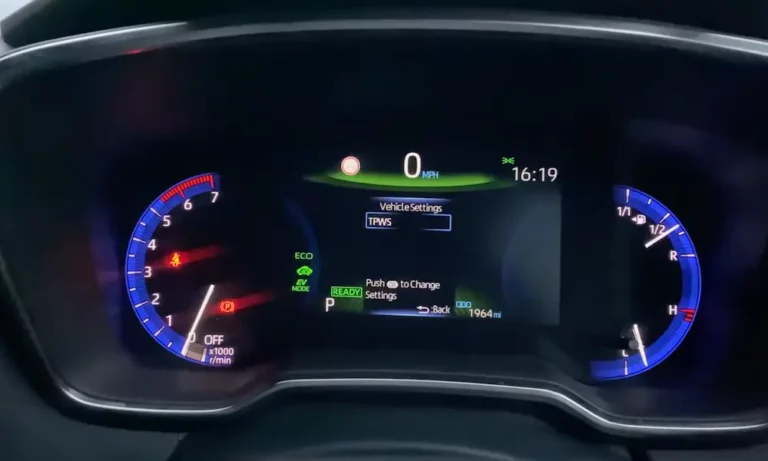You’ve seen it – that pesky tire pressure warning light glowing on your dashboard. For Toyota owners, the TPWS (Tire Pressure Warning System) is both a lifesaver and occasionally, a source of frustration. Whether you’re dealing with a blinking light or searching for answers, this guide will help you understand, diagnose, and fix Toyota TPWS malfunctions without expensive dealer visits.
What Exactly is Toyota’s TPWS?
Toyota uses a direct TPMS (Tire Pressure Monitoring System) in most vehicles. Each tire contains a battery-powered sensor that communicates wirelessly with your car’s computer. When tire pressure drops below 75% of the recommended level or when there’s a system problem, your dashboard lights up with a warning.
Unlike some manufacturers using indirect systems that measure wheel rotation differences, Toyota’s design provides real-time pressure readings from each individual tire. The sensors are typically integrated into the valve stems and transmit data on Toyota-specific frequencies.
How your warning appears matters:
- Solid light = Low tire pressure
- Blinking light = System malfunction
Common Causes of Toyota TPWS Malfunctions
Dead Sensor Batteries
The most frequent culprit behind TPWS issues is battery failure. These tiny batteries typically last 5-10 years before giving up. A common symptom is the warning light blinking before turning solid, as one 2015 Corolla owner discovered.
Unfortunately, you can’t replace just the battery—the entire sensor needs replacement when the battery dies.
Physical Sensor Damage
These delicate sensors can be damaged by:
- Road debris impacts
- Improper tire mounting/dismounting
- Water exposure and corrosion
In one telling case, a 2019 RAV4 Hybrid owner traced system failures to water-induced corrosion from a leaking roof rack.
Sensor Registration Problems
When you swap wheels or replace sensors, the new sensors must be registered with your vehicle’s computer. This is a common issue after:
- Switching between summer and winter tires
- Installing new wheels
- Rotating tires with aftermarket sensors
A 2023 4Runner owner faced this exact problem after installing new TireRack wheels, requiring dealership reprogramming.
Signal Interference
Your Toyota’s TPWS can experience interference from:
- Incompatible aftermarket sensors
- Nearby electronic devices
- “Cloned” sensors with duplicate IDs
This was the case for one Tacoma owner who discovered faulty aftermarket sensors were causing system errors.
ECU or Wiring Issues
Though rare, problems can stem from:
- Damaged control modules
- Corroded wiring connectors
- Software glitches in the vehicle’s computer
DIY Diagnosis: Is It A Real Problem?
Before heading to the dealer, try these diagnostic steps:
1. Check Your Tire Pressures
This sounds obvious, but start by confirming all tires (including the spare on some models) match the recommended pressure. Use a reliable gauge—don’t trust visual inspection.
Your target pressure is listed on the driver’s door jamb sticker. For example, many Highlander models recommend 36 PSI.
2. Reset The System
Different Toyota models have slightly different reset procedures:
Method 1: Using the Reset Button
- Turn ignition to “ON” (don’t start the engine)
- Locate the TPMS reset button (usually under the steering wheel)
- Hold it until the light blinks three times
- Drive above 25 mph for 20-30 minutes to complete recalibration
Method 2: Through the Infotainment System
- Navigate to “Vehicle Settings”
- Select “TPWS” then “Set Pressure”
- Hold the OK button until the light flashes
- On newer models (post-2019), you may need to select “Change Wheel” first
Newer Toyota models like the Avalon require a slightly different approach through the infotainment system.
3. Check for Blinking Patterns
If the light blinks for about a minute when you start the car and then stays solid, that typically indicates sensor battery failure. If it continues to blink, there’s likely a system malfunction.
Fixing TPWS Problems: Your Options
Sensor Replacement
When sensors fail, replacement is your only option:
OEM Sensors:
- Cost: $100-150 per sensor
- Installation labor: $50-100
- Dealership total: Often $240-374 per sensor including diagnostics
Aftermarket Sensors:
- Cost: $30-40 each from brands like Dill
- May require special programming tools
- Some are pre-programmed to work with specific Toyota models
One Toyota owner reported being quoted $374 to replace a single TPMS sensor at a dealership, highlighting the potential savings of aftermarket options.
DIY Programming Options
For the technically inclined, you can save money with these approaches:
TPMS Programming Tools:
- Tools like the Autel TS508 ($150-300) let you program new sensors
- Can clone existing sensor IDs to new sensors
- Allow registration after tire rotations
A Tacoma enthusiast successfully used an Autel tool to program sensors after discovering their aftermarket sensors were faulty.
Budget-Friendly Alternatives
Don’t want to buy specialized tools? Consider these options:
Tire Shop Services:
- Chains like Discount Tire often reprogram sensors for free with tire purchase
- Independent shops typically charge $25-50 for programming
Battery Reset Trick:
- Disconnecting your car’s battery for 15 minutes can reset the ECU
- This occasionally resolves persistent warning lights
- Not a permanent fix for actual sensor problems
Cost Comparison: Dealer vs. DIY vs. Tire Shop
| Solution | Cost for 4 Sensors | Pros | Cons |
|---|---|---|---|
| Toyota Dealer | $960-1,500 | Guaranteed compatibility, Full warranty | Highest cost, May require appointment |
| Aftermarket + Tire Shop | $170-250 | Significant savings, Professional installation | Variable sensor quality, Potential compatibility issues |
| DIY with Tool | $270-460 initial | Future DIY repairs, Complete control | Learning curve, Tool investment |
| Discount Tire | $120-200 | Convenient, Often includes installation | Limited sensor selection, Quality varies |
Preventing Future TPWS Problems
A little prevention goes a long way in avoiding TPWS headaches:
- Before Seasonal Tire Swaps: Make sure your tire shop has TPMS registration capabilities or learn the reset procedure for your specific Toyota model.
- Monitor Sensor Age: Consider proactively replacing sensors around the 7-year mark before they fail unexpectedly.
- Proper Tire Service: Choose shops with TPMS expertise, as improper mounting can damage sensors.
- Water Protection: If you frequently drive off-road or in heavy weather, inspect sensor connections for corrosion.
Toyota-Specific Model Notes
Different Toyota models have unique TPWS quirks:
4Runner: Particularly sensitive to aftermarket wheels and requires Techstream software for some resets.
RAV4/RAV4 Hybrid: The 2019+ models are prone to connector corrosion in locations where water can pool.
Camry/Corolla: Reset buttons are typically located under the steering wheel, making them easier for DIY resets.
Tacoma/Tundra: Often experience issues after lift kits or oversized tire installations that require recalibration.
Highlander: The system may need up to 30 minutes of driving above 25mph to complete recalibration after a reset.
When TPWS Malfunctions Point to Bigger Problems
Occasionally, TPWS errors indicate more serious issues:
Electrical System Problems: Persistent TPWS errors alongside other electrical glitches may indicate alternator or battery problems.
Water Intrusion: In some RAV4 and 4Runner models, TPWS errors have been early warnings of water leakage affecting other systems.
ECU Issues: Rare cases where multiple sensors fail simultaneously could indicate computer module problems requiring specialized diagnosis.
Understanding Toyota TPWS Technical Terms
TPWS vs. TPMS: Toyota uses TPWS (Tire Pressure Warning System) on their displays, while the industry generally refers to TPMS (Tire Pressure Monitoring System).
Direct vs. Indirect: Toyota primarily uses direct systems with physical sensors, rather than indirect systems that use wheel speed sensors.
Auto-Location: Newer Toyota models can automatically determine which tire is which after rotation, while older models require manual registration.
ID Registration: The process of teaching your Toyota’s computer to recognize specific sensor ID numbers after replacement or rotation.
Understanding Toyota’s tire pressure warning system doesn’t require an engineering degree. With the right knowledge, you can diagnose problems, choose the most cost-effective solutions, and even perform some fixes yourself. Regular maintenance and prompt attention to warning lights will help you maintain optimal tire pressure, improve safety, and avoid the frustration of persistent dashboard warnings.














